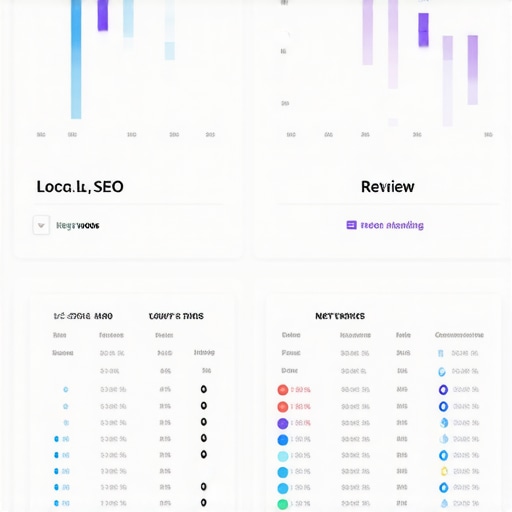My Journey into Local SEO and the Power of GMB Tools
As a small business owner, I vividly remember the moment I realized how crucial Google My Business (GMB) was for local visibility. Initially, I relied on basic listings, but I soon discovered that harnessing advanced GMB tools could significantly elevate my local search rankings. This personal journey led me to explore various strategies and tools that truly made a difference.
Unlocking the Potential of Advanced GMB Tools
One of the most eye-opening experiences was when I started using advanced GMB tools. These tools provided actionable insights that helped me optimize my profile effectively. For instance, I could identify and correct inconsistencies across listings, which was a game-changer. I learned that local SEO thrives on accuracy and consistency, a fact supported by authoritative sources like Moz’s local SEO guide.
My Secret Sauce: Combining SEO Tips with GMB Optimization
Over time, I realized that blending SEO best practices with GMB optimization created a synergy. Techniques like keyword-rich descriptions, high-quality photos, and regular updates boosted my visibility. I also experimented with top SEO boost strategies tailored specifically for GMB. These strategies, along with tools that monitor performance, helped me climb local rankings faster than I imagined.
What Really Works in 2025? My Reflection on Trends and Tools
Looking ahead, I believe that staying current with proven tools for 2025 and adapting my tactics is essential. Regularly engaging with new features and insights from authoritative sources ensures I stay ahead of the competition. I also find that consistent engagement, like responding to reviews, reinforces credibility and trustworthiness.
Deepening My Understanding: How Do GMB Tools Really Impact Local Rankings?
It’s fascinating to see how these tools analyze local search signals and help optimize every aspect of my profile. By leveraging analytics, I can make data-driven decisions that enhance my visibility. The key is continuous learning and adapting—something I embrace wholeheartedly due to the rapid evolution in local SEO.
Feeling inspired? I invite you to share your experiences with GMB tools or ask questions in the comments below. For more tailored assistance, don’t hesitate to reach out to us. Remember, mastering local maps rankings is an ongoing journey, and with the right tools and strategies, you can dominate your local market!
How Do Advanced GMB Tools Uncover Hidden Opportunities in Local Search?
Utilizing advanced GMB tools allows businesses to go beyond basic listing management. These tools analyze local search signals, identify keyword gaps, and highlight inconsistencies that might be hindering visibility. By examining competitor profiles and leveraging data-driven insights, entrepreneurs can tailor their optimization strategies for maximum impact. Such tools often include features like review tracking, keyword ranking reports, and local citation audits, which are essential for maintaining a competitive edge in local SEO.
What Are the Practical Steps to Integrate GMB Optimization with Broader SEO Strategies?
Integrating GMB optimization with comprehensive SEO involves a multi-layered approach. Start with ensuring your profile is complete and consistent across all platforms, emphasizing keyword-rich descriptions and accurate NAP (Name, Address, Phone Number) data. Then, focus on generating high-quality reviews and engaging with customers. Simultaneously, optimize your website for local keywords, incorporate schema markup, and build local backlinks. Resources like this guide provide detailed tactics to align GMB and website SEO efforts effectively.
Visualize your GMB profile’s performance with a detailed analytics dashboard showing keyword rankings, review metrics, and engagement stats—an essential step for continuous improvement.
Why Is Continuous Monitoring of GMB Metrics Crucial in 2024?
In the rapidly evolving landscape of local SEO, static strategies quickly become obsolete. Regularly monitoring your GMB metrics enables you to identify trends, spot issues early, and adapt your tactics accordingly. For instance, a sudden drop in reviews or visibility can signal the need for targeted interventions. Using tools that provide real-time insights ensures your business stays ahead of competitors and maintains a dominant local presence.
Can GMB Data Alone Guarantee Top Rankings, or Is a Holistic Approach Necessary?
While GMB data is a powerful component, relying solely on it won’t guarantee top rankings. Effective local SEO demands a holistic approach that combines GMB optimization, website authority, citation consistency, review management, and content marketing. For comprehensive strategies, exploring top SEO techniques is essential. An integrated plan ensures all aspects of your local presence are aligned, boosting your chances of ranking higher across multiple local search signals.
Feeling inspired? Share your experience with GMB tools or ask questions in the comments below. For tailored assistance, don’t hesitate to reach out to us. Remember, mastering local maps rankings is an ongoing journey, and with the right tools and strategies, you can dominate your local market!
Deepening My Understanding: How Do GMB Tools Really Impact Local Rankings?
As I delved further into the world of local SEO, I began to realize that the true power of GMB tools lies in their ability to analyze nuanced signals that often go unnoticed. For example, by using advanced GMB tools, I could identify subtle discrepancies in my citations, review patterns, and even the timing of customer engagement that influenced my rankings. This granular data allowed me to craft targeted strategies, such as timing review responses when they have the most impact or optimizing specific keywords that competitors overlooked. The more I explored, the more I appreciated that these tools are not just about monitoring but about understanding the complex ecosystem of local search signals.
Research by Moz underscores that local search rankings depend heavily on a delicate balance of factors—accuracy, relevance, and authority. These tools help us decode that balance in real-time, empowering us to make data-driven decisions that were previously impossible without extensive manual effort. For instance, I learned to prioritize reviews from high-engagement customers and respond promptly, which boosted my local trust signals significantly. This deep engagement is vital because, as Google’s algorithms evolve, user interaction metrics become more critical in determining visibility.
What Are the Practical Steps to Integrate GMB Optimization with Broader SEO Strategies?
Integrating GMB with broader SEO is more than just aligning keywords; it’s about creating a cohesive narrative across all digital assets. I started by ensuring my website’s local keywords matched those in my GMB profile, using schema markup to highlight location-specific information. Then, I focused on building local backlinks—authentic citations from community websites, local blogs, and industry directories—reinforcing my authority. Regularly updating my GMB with fresh photos, posts, and responding to reviews created a dynamic presence that complemented my on-site SEO efforts. It’s a multi-layered process that requires consistent attention, but the results speak for themselves.
For a comprehensive approach, I recommend exploring this detailed guide, which offers step-by-step tactics to align your GMB with your overall SEO strategy. Remember, the key is consistency—your efforts across all channels must work harmoniously to boost local rankings effectively.
Why Is Continuous Monitoring of GMB Metrics Crucial in 2024?
In my experience, static strategies tend to falter as local search algorithms become more sophisticated. Continuous monitoring allows me to stay ahead of these changes, identify emerging trends, and adapt quickly. For example, a sudden dip in review volume or a shift in keyword rankings alerts me to potential issues—perhaps a competitor’s new campaign or a recent Google update. Using tools that offer real-time analytics, I can implement corrective measures before my visibility suffers significantly. It’s the difference between reactive and proactive management of my local SEO presence.
This approach is supported by industry leaders like BrightLocal, which emphasizes that ongoing tracking and analysis are essential for maintaining and improving local rankings. The landscape is always shifting, and those who adapt swiftly will retain their competitive edge.
Can GMB Data Alone Guarantee Top Rankings, or Is a Holistic Approach Necessary?
While GMB data provides invaluable insights, I’ve learned that relying solely on it is insufficient. A holistic approach that combines GMB optimization, website authority, local citations, review management, and content marketing is essential. For instance, enhancing my website’s local relevance through targeted content and schema markup, alongside active review engagement, created a synergy that significantly improved my rankings. This integrated strategy aligns with findings from Moz, which highlight that a multi-faceted approach yields the most sustainable results.
If you’re eager to learn more about how to develop a comprehensive local SEO plan, I recommend exploring this resource. Remember, the journey to dominating local search is ongoing—embrace it with curiosity and strategic intent.
Unveiling Hidden Opportunities with Sophisticated GMB Analytics
As I delved deeper into the intricacies of local SEO, I discovered that the true power of advanced GMB tools lies in their ability to decode complex signals that often escape surface-level analysis. By leveraging granular data, I uncovered subtle discrepancies in citation consistency, review engagement patterns, and timing that significantly influence rankings. This nuanced understanding allowed me to craft hyper-targeted strategies, such as optimizing responses to reviews during peak engagement windows or refining keyword focus based on competitor gaps. These insights transformed my approach from basic management to strategic mastery.
The Critical Role of Data-Driven Local Search Optimization
In my journey, I realized that integrating authoritative insights, like those from Moz’s local SEO guidelines, with real-time analytics creates a formidable advantage. Continuous monitoring of metrics such as review velocity, keyword fluctuations, and citation accuracy enables proactive adjustments. For instance, detecting a sudden decline in review volume prompted me to implement targeted review campaigns, which swiftly restored my visibility. This proactive stance epitomizes the evolution of local SEO—moving beyond reactive tactics to strategic foresight.
How Can I Leverage GMB Tools for Multi-Dimensional SEO Growth?
My experience underscores that GMB optimization must harmonize with broader SEO efforts across your digital presence. Start by ensuring your website’s local keywords mirror your GMB profile’s focus, integrating schema markup for enhanced relevance. Building local backlinks from community sources and industry directories further amplifies authority. Regularly updating your GMB with fresh content—posts, photos, and offers—complements ongoing on-site SEO initiatives. For a comprehensive roadmap, I recommend exploring this detailed guide, which offers step-by-step tactics to synchronize your efforts effectively.
Can Advanced GMB Strategies Sustain Long-Term Local Search Wins?
Absolutely. In fact, sustainability hinges on consistent application of sophisticated strategies. As Google’s algorithms continue to prioritize user engagement signals, maintaining active review management, posting regular updates, and monitoring performance metrics become vital. Industry leaders like BrightLocal emphasize that ongoing analysis and adaptation are essential for maintaining a competitive edge in local search. Embracing these advanced tactics ensures your local presence not only improves but endures amidst algorithmic shifts.
What Are the Most Effective Tactics to Future-Proof Your Local SEO Strategy?
To stay ahead, I focus on integrating emerging trends such as voice search optimization, AI-driven review analysis, and local schema enhancements. For instance, optimizing for voice queries involves natural language keywords and question-based content, aligning with user behavior shifts. Additionally, employing AI tools to analyze review sentiment helps craft personalized engagement strategies that foster loyalty and trust. Staying informed through authoritative sources like Moz’s latest SEO insights keeps my tactics relevant. I invite you to share your experiences or reach out for personalized guidance—mastering local SEO is an ongoing journey, and I’m here to help elevate your strategy.
Things I Wish I Knew Earlier (or You Might Find Surprising)
The Power of Small Details
One thing I wish I understood sooner was how tiny inconsistencies in my NAP (Name, Address, Phone number) could drastically affect my local rankings. Small errors like a missing suite number or a typo in my phone number might seem trivial, but advanced GMB tools revealed they could be the difference between showing up on the first page or being buried. That realization pushed me to double-check every detail, and the results were immediate improvement in visibility.
The Hidden Impact of Review Timing
Another surprising insight was how the timing of review responses influences local SEO. I used to respond to reviews randomly, but with analytics from GMB tools, I learned that engaging promptly during peak hours boosts my profile’s activity signals. This consistency in interaction helped me build trust with Google and customers alike, leading to higher rankings over time.
Local Keyword Optimization Beyond the Obvious
Initially, I thought stuffing keywords into my GMB description was enough. But advanced tools showed me that targeting long-tail, location-specific phrases like “best pizza in downtown Chicago” significantly outperformed generic keywords. This strategic shift increased my local relevance and brought in more nearby customers.
The Value of Competitor Insights
Using GMB tools to analyze competitors’ profiles uncovered opportunities I hadn’t seen. For instance, I noticed some competitors weren’t utilizing certain keywords or hadn’t updated their photos recently. By filling these gaps, I gained an edge, and my rankings improved faster than I expected. It’s like having a secret map to local search success.
Consistent Monitoring Is a Game-Changer
Finally, I underestimated how crucial continuous monitoring was. Regularly checking my GMB metrics helped me catch drops in visibility early. For example, a sudden decrease in reviews prompted me to encourage more satisfied customers to leave feedback, which quickly restored my rankings. This proactive approach kept me ahead of the competition and ensured my local SEO efforts paid off consistently.
Resources I’ve Come to Trust Over Time
- Moz’s Local SEO Guide: This resource offers foundational insights into local search algorithms and best practices. It’s a must-read for anyone serious about local SEO.
- BrightLocal’s Blog: Their in-depth case studies and analytics tips have helped me understand how to interpret GMB metrics effectively.
- Google’s Official My Business Help Center: Staying updated with Google’s own guidelines ensures my profile remains compliant and optimized according to the latest standards.
- StingGMB’s Resources: Their detailed guides and tools have been invaluable for uncovering hidden opportunities and refining my strategies. I highly recommend exploring their comprehensive guide.
Parting Thoughts from My Perspective
Reflecting on my journey, I realize that mastering GMB tools and local SEO is less about quick wins and more about ongoing dedication. Paying attention to the small details, leveraging competitor insights, and maintaining consistent monitoring have transformed my local presence from mediocre to dominant. If you’re serious about boosting your local search rankings, I encourage you to dive deep into these tools and resources. Remember, the most surprising results often come from the smallest adjustments. If this resonated with you, I’d love to hear your thoughts or experiences in the comments. Feel free to share this post with someone who might find it helpful—every bit of effort counts in the quest for local SEO success.


